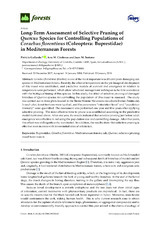Long-Term Assessment of Selective Pruning of Quercus Species for Controlling Populations of Coraebus florentinus (Coleoptera: Buprestidae) in Mediterranean Forests
Autor
Gallardo de la Torre, Patricia
Cárdenas, Ana M.
Soriano, Juan M.
Editor
MDPIFecha
2018Materia
BuprestidaeCoraebus florentinus
Mediterranean forests
Oak
Quercus
Selective pruning
Wood borer insects
METS:
Mostrar el registro METSPREMIS:
Mostrar el registro PREMISMetadatos
Mostrar el registro completo del ítemResumen
Coraebus florentinus (Herbst) is one of the most important wood borer pests damaging oak
species in Mediterranean forests. Recently, the effect of temperature on the pre-imaginal development
of this insect was established, and predictive models of survival and emergence in relation to
temperature were performed, which allow scheduled management techniques to be fit in accordance
with the biological timing of this species. In this study, the effect of selective pruning of damaged
branches of Quercus species for controlling the population of this insect is assessed. The study
was carried out in three plots located in the Sierra Morena Mountains (southern Iberian Peninsula).
In each plot, forest features were typified, and the parameters “infestation level” and “population
intensity” were quantified. The assessment was performed one year and five years after applying
selective pruning. The most effective time to prune was established according to the predictive
model mentioned above. After one year, the results indicated that selective pruning just before adult
emergence was effective in reducing the population size and controlling damage. After five years,
this effect was still significantly manifested. In addition, the results show that selective pruning is
effective even in areas with lower initial rates of infestation

